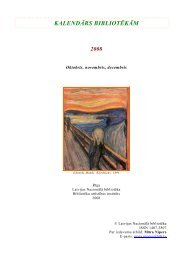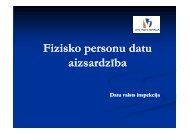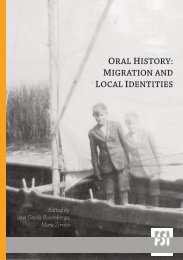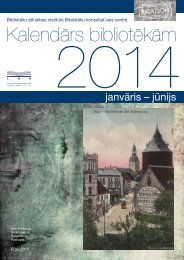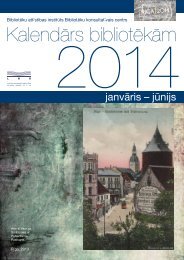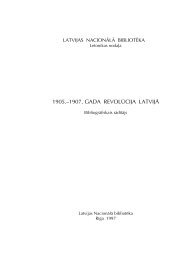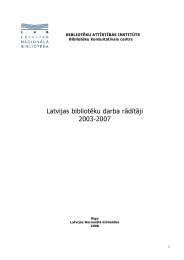LAIKU ATŠALKAS: ŽURNĀLISTIKA, KINO, POLITIKA - Academia
LAIKU ATŠALKAS: ŽURNĀLISTIKA, KINO, POLITIKA - Academia
LAIKU ATŠALKAS: ŽURNĀLISTIKA, KINO, POLITIKA - Academia
You also want an ePaper? Increase the reach of your titles
YUMPU automatically turns print PDFs into web optimized ePapers that Google loves.
<strong>LAIKU</strong> ATŠALKAS: ŽURNĀLISTIKA, <strong>KINO</strong>, <strong>POLITIKA</strong>Aija RozenšteineDoctoral student, University of Latvia, Department of Communications StudiesTHE HISTORY OF THE FILM “IS IT EASY TO BE YOUNG?”Its production, its approval, its appearance onscreenKeywords: Latvian documentary cinema, “Is it Easy to be Young?”, Juris Podnieks, Ābrams Kleckins,Jevgēnijs Margoļins, problems of young people, glasnostThe Rīga Film Studio documentary “Is it Easy to be Young?” made a big splash in Latvia.It was produced during the period of perestroika, and it was only thanks to the restructuringand greater openness of the Soviet system at that time that the film made it to cinema screens.There are historians who have described the period between 1983 and 1985, when the producersof the film wrote its screenplay and began to produce it, as the “embryonic period ofperestroika.” 1The destiny of the film had everything to do with what was happening in the Soviet Unionat that time. We must remember that glasnost and perestroika were the foundation for the decisionto allow the film to be produced and put onscreen. At the same time, however, glasnostand perestroika would not have been possible without such films. The point is that the filmneeded glasnost and perestroika, but glasnost and perestroika needed the film to illustrate theprocesses of change.“Is it Easy to be Young?” was released by director Juris Podnieks in 1986. The film dealswith the lives of young people and the purpose of their lives. It reveals the forced pointlessnessand hypocrisy of the Soviet system, taking a major step in the direction of true revelations.In this paper, the author has correlated and analysed archival materials about the film, interviewedits producers, and reviewed articles about it. This creates an overall scene which describesnot just the production of the film, but also the relevant transformations in society. Theanalysed documents lay bare a lack of correspondence because the form and essence of the text,because while the content of the documents did not change, the documents did support changesin society which at that time were not yet quite evident.Before gaining permission to work on their film, the producers had to submit an applicationto the authorities that was convincing and in line with the spirit of the times. They had to waitfor conclusions and reviews in which support for the intended film would be indicated.One of the authors of the screenplay, Ābrams Kleckins, has said that initially the film was afact of society, a social event. Later, however, it became an artistic event, because the film wasnot just an historical fact. It was also a component of culture which showed that even in 1986,people could talk about freedom, internal freedom and democracy which exist not in laws, butin people themselves. 2The importance of the film is also seen in the fact that 28 million people saw it in Sovietcinemas during the first year after its release. Later it would be shown in more than 80 countriesin the world. 31Barsenkov, A.C. and A.I. Vdovniy. “История России. 1917-2004” (History of Russia, 1917-2004). Moscow:Aspect Press (2005), p. 588.2Interview with Kleckins, 17 August 2008, transcript in the archives of the author.3Information from the DVD of “Is it Easy to be Young” (2007). Rīga: Juris Podnieks Studio.223



